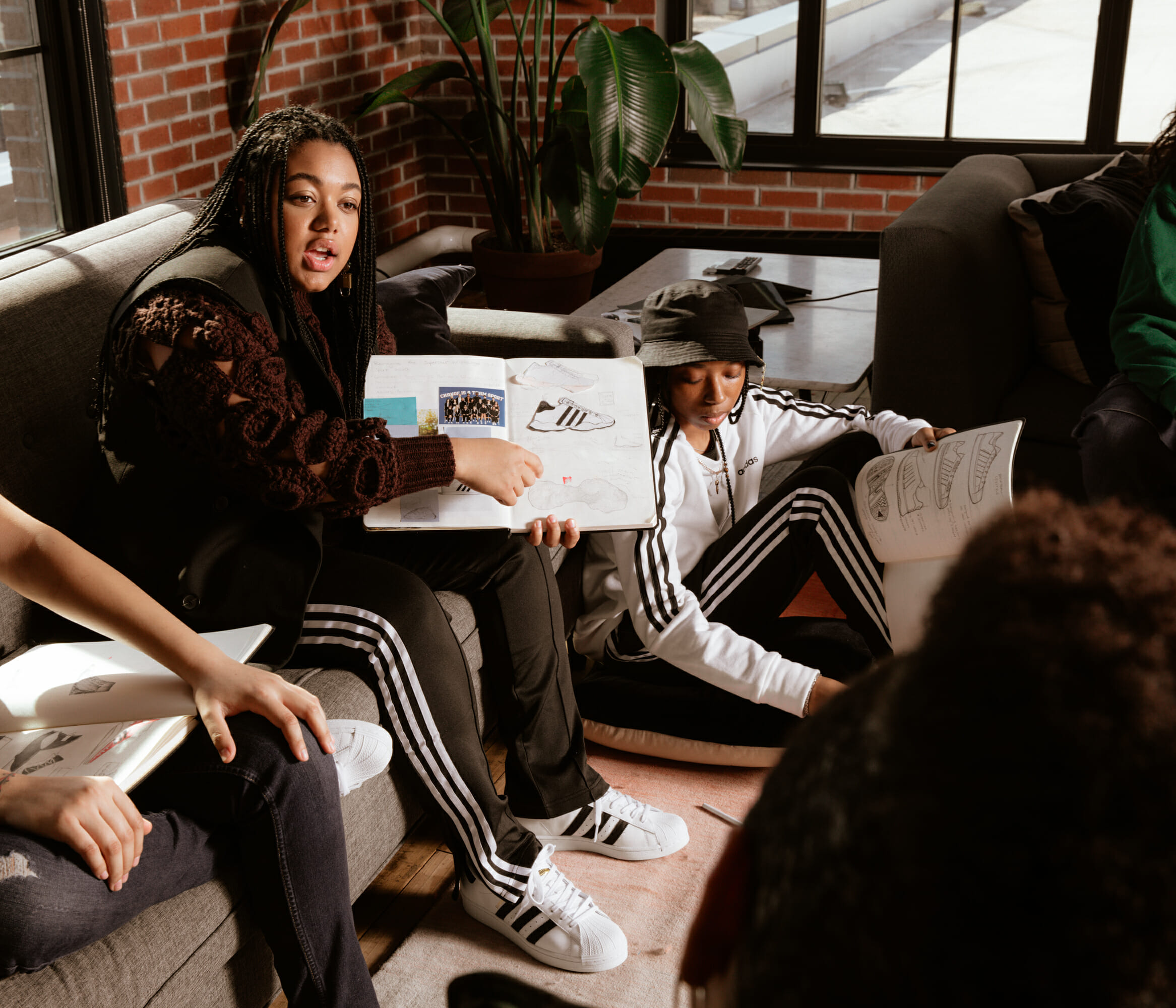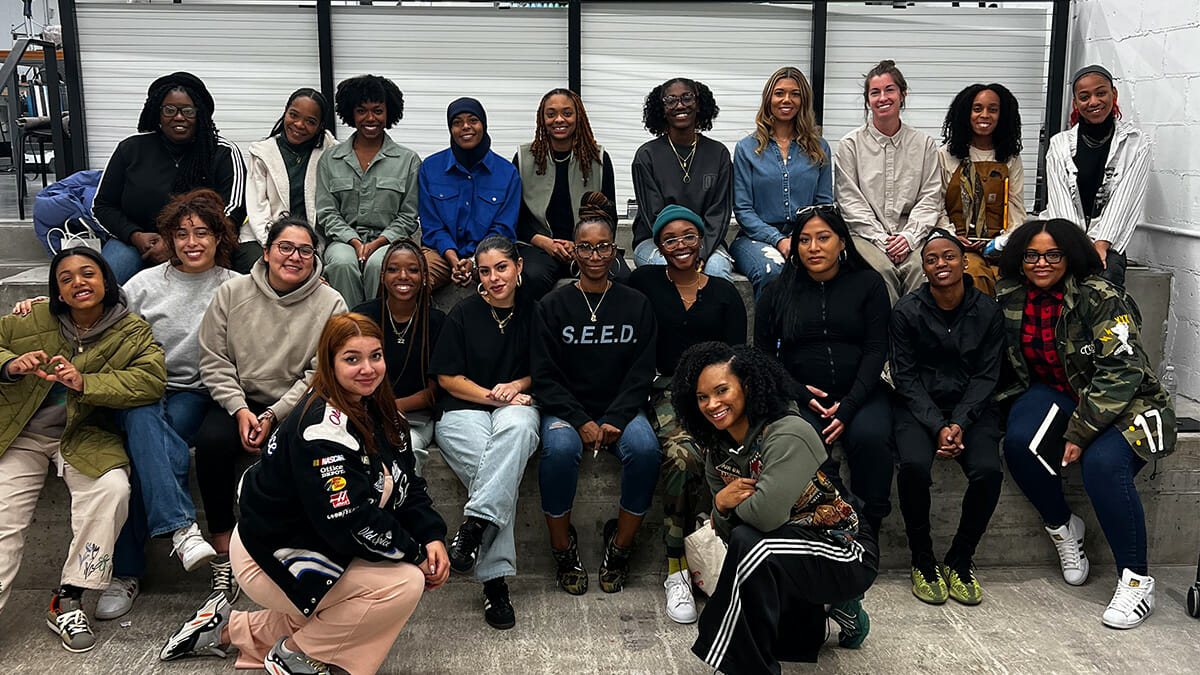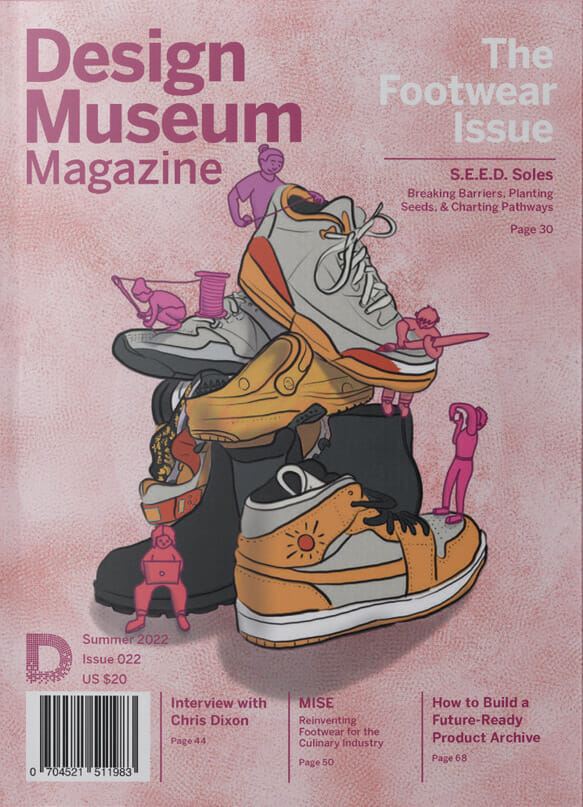S.E.E.D. Soles: Breaking Barriers, Planting Seeds, & Charting Pathways

By Cheresse Thornhill-Goldson, S.E.E.D. Design Director & Jessica Smith, S.E.E.D. Co-Founder
Born in love. Raised in hustle. Refined by the streets. It all started with a basket-ball and a notebook.
At first it was to keep up with her brothers. It evolved into cherished time with her father. And then, it took root in her heart. Everything about the game of basketball fueled her: the competition, the comradery, the style, the fashion, and of course, the shoes! Seeing her late-night blacktop work translated into buckets and shammies. Knowing her vision and leadership inspired greatness in her teammates. Feeling the grind of the city and the walls between blocks and crews erode in an instant as the announcer picked up the mic and the crowd went crazy. It was more than a game; it was life. It was more than a team; it was friendship. It was more than an audience; it was community.
As her high school years inched by, the reality of hanging up her sneaks became increasingly real. Now, all she was left with were memories and an unfunded shoe obsession. The things she had loved, that had been her identity, couldn’t carry her forward into the next phase of her journey.Or so she thought…Blue collar workers were who she saw around her, people working two or three jobs to put food on the table. Her parents passed in the night working odd hours to ensure someone was home to support them. She admired her parents’ ability to turn love and hustle into a close-knit family unit, but she couldn’t imagine going down the same path. With a roof over her head, she took the train to the only stop that gave her more time… community college. It only took one week of classes for that pit to develop into a boulder, realizing that this open road of exploration was merely a high school extension that lacked the support or guidance she needed to explore how to turn her passion into purpose.While fictional, Dream’s story is that of many young women of color from under-resourced communities around the world.
There is a debate spanning centuries on the purpose of education and its relationship to workforce readiness. Is education intended for the sole purpose of personal edification? Or is there a place for career and technical education within the educational system? The lack of resolution in this ongoing debate has resulted in career interest formation and preparation frequently being managed through informal networks. Informal networks are a gateway for inequity, allowing social and cultural capital disproportionally privileging some and perpetuating discrimination for marginalized communities.The global athletic footwear industry is a 97-billion-dollar industry (1) with black and 32 brown consumers fueling a disproportionate percentage of purchases. So how can it be that the main relationship the Black and Brown community has with the industry is purchasing? The industry is founded on the richness of cultures that lack access to benefit from the profitability it drives. The problems that sit behind Dream’s story are vast. Consumerism, the inequity of underrepresentation, the business impact of homogeneous teams…the list goes on. But let’s just sit with this one.

S.E.E.D. Creator Camp
Imagine if when you were born, or the moment your child was born, that someone would tell you that everything about your life had already been determined. The dimensions of your identity, your age, socioeconomic position, race, ethnicity, nation of origin, and gender could predict the schools you would attend, the profession you would have, your earning potential, and much more.
While the structure of our society has created that reality, we are a fearless team committed to break inequitable systems by overlaying an equity lens across the education to career pathway. So that little girls like Dream, who love basketball, fashion, art, and sneakers, can take their passions cultivated as children and have clear and accessible pathways to turn those passions into meaningful lives and careers of purpose.
The Solution
The School for Experiential Education in Design (S.E.E.D.), was founded by Jessica Smith & Liz Connelly within adidas and welcomed its first cohort in January of 2020. The program is a paid two year university alternative, footwear design program for BIPOC women from diverse backgrounds creating further access into the Adidas brand and sportswear industry. Upon successful completion of the program each designer transitions into a permanent full-time design role within adidas. The program is housed at the adidas Brooklyn Creator Farm in partnership with Pensole Lewis College of Business & Design, the first HBCU dedicated to design located in Detroit, MI. S.E.E.D. is revolutionizing the design, education, and sportswear industries by operating as a diverse talent pipeline, taking a creator-centric approach to design education, and serving as an inclusive design consultancy within the adidas brand fueling the marketplace with consumer relevant products. “Girls like me, an African American girl from Miami, usually didn’t want to go for art or design. Not having enough chances was a barrier for me…S.E.E.D. can inspire the younger generation that’s coming, those that want to design but are afraid to or feel like they don’t have an outlet” said Eliya Jackson, adidas Assistant Footwear Designer, (S.E.E.D. Generation 1).
Talent Pipeline & Humanizing The Recruiting Process
S.E.E.D.’s “human centered” approach to talent recruitment eradicates the barriers to entry erected by traditional recruiting practices designed to filter out those who have been under-resourced and overlooked. Our recruiting process, led by co-founder Liz Connelly, focuses on an individual’s ability to communicate who they are as a creative, an ability to exhibit their unique creative superpower, collaborate with others, build community, display a growth mindset, be teachable, learn quickly, and graciously welcome feedback. We conduct design workshops, “Creator Camps,” that enable us to get to know prospective S.E.E.D. design students in an environment focused on fun, learning, compassion, and unity – not competition, isolation, and elitism.
“I was someone who didn’t know where I was going in life, I just knew I had to go somewhere, anywhere. I don’t come from money, so I had to drop out of my first year of college…Then all of a sudden this amazing opportunity is at my doorstep, and it brought me back to life and I found my passion in something I never thought I would…What adidas is doing with the S.E.E.D. program is out of this world, they created this program for women from any background and really took the time to get to know us and our story and look at us for our skills rather than our degree,” said Samantha Alvarado, Adidas Assistant Footwear Color Designer, (S.E.E.D.Generation 1).
Our creator camp enables us to provide our participants with a mini S.E.E.D. experience focused on leadership skill development via a lesson on identity dimensions and a footwear design lesson focused on consumer insights, product narrative, sketching, color, graphics, materials, storytelling, collaboration, and presentation. Once prospective students have attended as many creator camps as they desire, they are prepared to apply for full-time placement within S.E.E.D. Each July we onboard a new cohort of 6 BIPOC women into the program based in Brooklyn, NY. S.E.E.D. serves as a strategic pipeline for female BIPOC design talent into the industry and the brand.
Creator-Centric Design Education Accelerated By Leadership
Traditional post-secondary design programs focus heavily on technical design skills and not enough on leadership skills and helping students identify their point-of-view that brands seek. Designers who have been traditionally trained and attended top design programs within the U.S. still experience a large gap in knowledge once they land their first corporate design job. These gaps may not heavily impact their technical abilities but definitely impacts their design identity (creative uniqueness), confidence, collaboration and their ability to understand and navigate workplace culture effectively. Therefore S.E.E.D. takes a “creator-centric” approach to design education. This means that we center our students’ points-of-view and learning styles, with room to adapt to their needs. We accomplish for our students in two years what colleges and universities achieve in four. What acceler-ates our student’s design skills and career read-iness, enabling them to learn and adapt quickly, is our leadership curriculum. Our leadership curriculum focuses heavily on identity, behaviors that fuel innovation, establishment of creative practices, and professional development. Our design curriculum, which is powered by our leadership curriculum, enables each designer to approach design through their own unique lens, instead of designing in the same manner as more senior designers in the industry. We leverage the collective genius of community to accelerate our creators’ growth. We partner with veteran designers as mentors. The open-source nature of our creator-centric approach ensures that S.E.E.D. designers received a well-rounded view of design from an industry perspective.
“Having all the wonderful women that are in the program with me, everyone’s just been so supportive. They give me insight into how I should present my work, how I need to story tell. They’re giving you a whole platform and opening the door for you. Ultimately, I just want to be my best me and I want to unleash my inner creative monster”, said Cristina Lopez, adidas Assistant Footwear Designer, (S.E.E.D. Generation 1).
Inclusive Design Consultancy
S.E.E.D. is strategically positioned at the inter-section of business and education which affords our designers the unique opportunity to learn by doing. Our designers are participating in a hands-on learning experience, designing products for real people to be sold at retail stores around the world. Black and brown women make up an extremely small percentage of foot-wear design teams but are the most marketed to. Therefore, products created for us but not by us lack truly relevant points-of-view. S.E.E.D. designers embody youthful perspectives of BIPOC women across the country which enables us to offer unique product solutions as we partner with various business units within the brand, operating as an inclusive design consultancy internally and externally.
As designers we have the great privilege of ascribing meaning to inanimate objects. Shoes are cultural icons and throughout pop culture we can pinpoint the shoes that defined an era or a moment in history such as Cinderella’s glass slipper, Dorothy’s Ruby Red slippers, Marty McFly’s Nike Air Mags, Kayne’s Red Octobers, Michael Jordan’s “Banned” AJ1 or “Flu Game” AJ XI and Run DMC’s “My adidas” Superstars. We believe no worn product expresses our person-ality more than shoes. Our shoes carry not only our bodies but our memories and signify special moments in our lives. Our first day of school, our wedding day, the first dunk on a basket-ball court, our first marathon or our bronzed baby shoes. We are keenly aware of the power of meaning and storytelling, which is a key focus of S.E.E.D.’s design philosophy and baked into every product we create, always deeply rooted in consumer insights.

Chandricka Carr, Daziah Green, Kimmiski Adams (S.E.E.D. Generation 2 Students)
Product
Our first product, designed by S.E.E.D. Generation 1, was the color and material application on the iconic adidas Superstar released in the Spring of 2021. During the midst of the pandemic in March 2020, our team was tasked with inspiring consumers who would have been indoors for months to rediscover nature and its positive effects. With this in mind, we took a utili-tarian approach to the color and material choices, focusing on calming shades of olive and dark green reminiscent of the colors of Brooklyn’s Prospect Park. We also added pops of khaki, cream, and gold details to complement that palette and the utilitarian product narrative. Color psychology is a key focus within our color design curriculum. As we discovered that orange signifies creativity, the team applied orange to the sock liner and inner lining of the entire shoe to inspire creativity within the wearer. This colorway resonated with consumers so much so that all 2000 pairs sold out within a few weeks in New York City.
S.E.E.D. partnered with the adidas Women’s Originals business unit on our 2nd footwear project and 1st collection. This adidas Forum collection known as “The Journey to Ultimate Confidence” was released around the world in the summer of 2021. The entire collection was born out of the insight that “confidence is a muscle, it’s always present, it just needs to be trained.” The four-shoe collection reveals each chapter of the story, one shoe at a time. The Forum mid, “The Court,” kicks off the narrative with the idea that the basketball court is the new gym, a place to begin exercising confidence. This silhouette celebrates the sport by displaying basketball textured leather on the upper with pops of bright colors inspired by the Pigalle court in Paris. The next chapter of the story, “The Sidewalk” is brought to life by the Forum Low. The front of the shoe signifies the “wind down” of comfort, relaxation and rejuvenation needed after a workout and the rear of the shoe celebrates the “turn up” with friends both of which are needed on the ultimate journey to confidence. The Forum Plus, the third silhouette in the collection, is the plateau of the narrative before the final crescendo. Known as “The Runway” this is the refinement stage where confi-dence is peaking and revealed via the soft pink synthetic python leather with hints of confident red tones exuding from the seams. The final shoe in the collection we nicknamed “The Met” is the ultimate expression of confidence. The all-red Forum Bold is adorned with synthetic python leather and satin laces. The cherry on top is the “red thread” that connects all 4 shoes together. All four shoes have a red outsole and red interior. Confidence is always present; it just needs to be developed to rise to the surface.
This is only the beginning, and we have more products planned to hit the marketplace designed by our Generation 2 cohort. By experiencing the full product creation process from brief to retail, our designers are well equipped by the end of the program to assume full-time design roles within the industry and specifically within adidas.
“I instantly fell in love with design and the product we were creating, from the process, consumer, research, sketching and color. It’s been an amazing journey…You have all been an inspiration for me. I couldn’t be more excited to start this next adventure, and I owe it all to S.E.E.D.,” said Samantha Alvarado, Adidas Assistant Footwear Color Designer, (S.E.E.D. Generation 1).
Our Generation 1 (2020) cohort have success-fully completed the program and have assumed their roles within various business units within the brand such as adidas Basketball, Team Licensing, and Top Creators. It has been amazing to watch our students fully develop into the creative leaders we saw glimpses of during our very first creator camp, and now, they’re out of the nest and taking the world by storm.
“To get here it took 1,000 tries but we have made it this far…I will take this opportunity and multiply it by 1000x… This is only the begin-ning, and this accomplishment is a reminder to always work towards your dreams, no matter how far it seems somehow you will get there!”, said Deannelys Corcino, adidas Assistant Apparel Designer, (S.E.E.D. Generation 1).
The Future
The future is bright for S.E.E.D. We will continue to create awareness of creative fields and look to expand opportunities and create pathways within footwear design for women from diverse back-grounds in the U.S., and globally in the future. Our Generation 2 design team is approaching the end of the first year and will transition into the second during the summer. They’ve already completed a footwear colorway and a collection of backpacks for the fall, just in time for “back to school,” both of which will launch next year. We’re presently wrapping up our recruitment process for our third Generation design team and look forward to welcoming them into the program this summer. Our long list of aspira-tions includes charting courses into the other jobs within product creation such as marketing, development, engineering, and manufacturing. The industry is ripe with opportunity and young creative women of color, like Dream, will be the difference makers.


